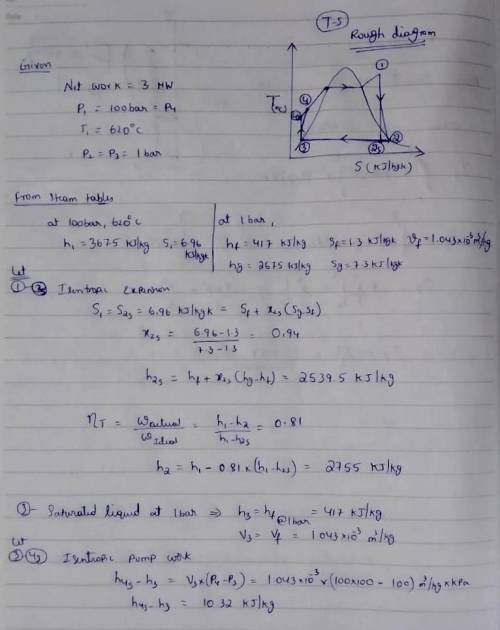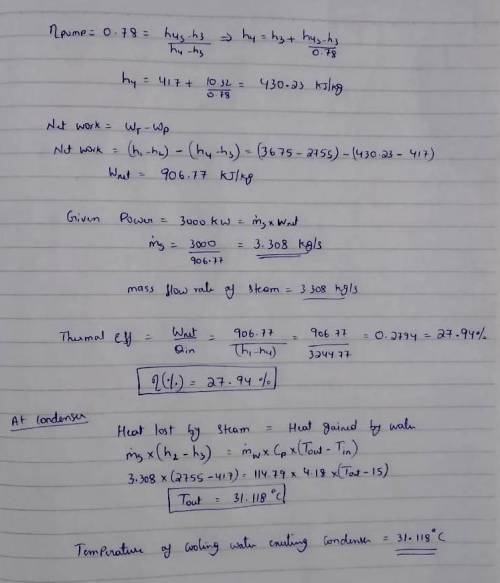
Engineering, 22.04.2020 01:28 sihaya43
Thermodynamics A nuclear power plant based on the Rankine cycle operates with a boiling-water reactor to develop net cycle power of 3 MW. Steam exits the reactor core at 100 bar, 620°C and expands through the turbine to the condenser pressure of 1 bar. Saturated liquid exits the condenser and is pumped to the reactor pressure of 100 bar. Isentropic efficiencies of the turbine and pump are 87% and 78%, respectively. Cooling water enters the condenser at 15°C with a mass flow rate of 114.79 kg/s. Determine: (a) the percent thermal efficiency. (b) the temperature of the cooling water exiting the condenser, in °C.

Answers: 3


Another question on Engineering

Engineering, 04.07.2019 18:10
Ajournal bearing has a journal diameter of 3.250 in with a unilateral tolerance of 20.003 in. the bushing bore has a diameter of 3.256 in and a unilateral tolerance of 0.004 in. the bushing is 2.8 in long and supports a 700-lbf load. the journal speed is 900 rev/min. find the minimum oil film thickness and the maximum film pressure for both sae 20 and sae 20w-30 lubricants, for the tightest assembly if the operating film temperature is 160°f. a computer code is appropriate for solving this problem.
Answers: 3

Engineering, 04.07.2019 18:10
True or false (explain) (110)[111] is a slip system in bcc metals . the {111} family in fcc contains 8 planes. resolved shear stress (rss) in single crystals is just related to the applied stress. critical resolved shear stress (crss) in single crystal metals is direct proportional to the number of defects in the structure
Answers: 2

Engineering, 04.07.2019 18:10
The flow rate of air through a through a pipe is 0.02 m5/s. a pitot static tube is placed in the flow. the radius of the pitot static tube is 1 mm. assuming the flow to be steady and the air to be at 300k, calculate the difference in total and static pressure if the diameter of the pipe is: (a) d 0.1 m d 0.05 m (c) d 0.01 m
Answers: 2

Engineering, 04.07.2019 18:20
Derive the correction factor formula for conical nozzle i=-(1+ cosa) and calculate the nozzle angle correction factor for a nozzle whose divergence hal-fangle is 13 (hint: assume that all the mass flow originates at the apex of the cone.
Answers: 3
You know the right answer?
Thermodynamics A nuclear power plant based on the Rankine cycle operates with a boiling-water reacto...
Questions

Mathematics, 15.10.2019 12:30

Geography, 15.10.2019 12:30

Mathematics, 15.10.2019 12:30




History, 15.10.2019 12:30

Mathematics, 15.10.2019 12:30

Biology, 15.10.2019 12:30

Biology, 15.10.2019 12:30


Social Studies, 15.10.2019 12:30

Mathematics, 15.10.2019 12:30

Mathematics, 15.10.2019 12:30

History, 15.10.2019 12:30

History, 15.10.2019 12:30

Biology, 15.10.2019 12:30

Mathematics, 15.10.2019 12:30






